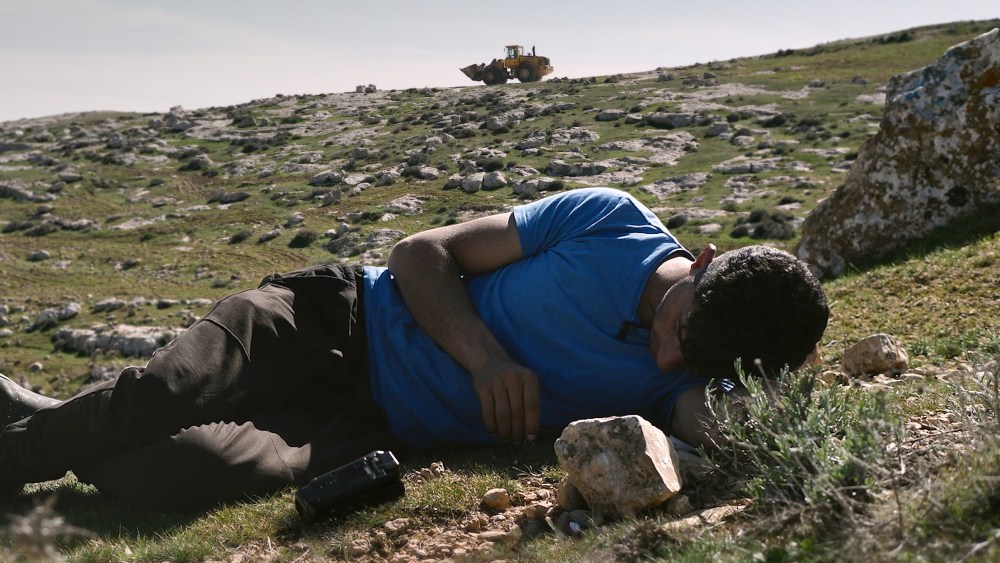Devastating Protest Against Israeli Occupation
It is any parent’s hope that their children won’t inherit their battles, or at the very least, that they can pass the generational baton with some ground gained. For young Palestinian lawyer and activist Basel Adra, a West Bank native who grew up watching his activist parents fight to protect their land from Israeli occupiers, there has been no such progress: Time has stood dispiritingly still as he has aged into his elders’ shoes. Adra is a resident of Masafer Yatta, a network of Palestinian villages in the southern Hebron Hills, recently subject to an aggressive campaign of demolition and forced transfer by the Israeli army. As his community is literally bulldozed before his eyes, Adra has little scope to do anything but keep his camera on: “I have nothing else, only my phone,” he despairs. That, thankfully, is not nothing. In the shattering documentary “No Other Land,” Adra’s witnessing becomes ours.
Premiering at the Berlinale not four months after Hamas’ October 7 operation into Israel was followed by Israel’s large-scale invasion of the Gaza Strip — an assault that has killed over 28,000 Palestinians — “No Other Land” might be called timely. But through its years-spanning depiction of both the mortal danger and mental strain of living under occupation, the film underlines that the situation has been at crisis point for a long time, whether or not it’s been grabbing international headlines. The project began in 2019, when Adra met Yuval Abraham and Rachel Szor, Jerusalem-based journalists reporting on Israeli evictions of local residents, and offered his first-hand perspective on events.
Together with Hamdan Ballal, another Masafer Yatta activist, they formed a filmmaking collective that, despite its Palestinian-Israeli makeup, has little interest in both-sides-ism. The doc benefits from Abraham and Szor’s journalistic nous (with Szor gaining often remarkable access as its chief DP) and freedom of movement, but the Palestinian experience and point of view is centered throughout. The chasm between Adra’s and Abraham’s respective acquaintances with the conflict is pointedly underlined, too. At one point, as Abraham bemoans the lack of online engagement with his latest report, Adra chides him for his self-serving exasperation: “You want to end the occupation in ten days — it requires patience.”
Beginning in the summer of 2019, the film divides itself into season-based chapters that illustrate both the relentlessness of the Israeli army’s offensive on Masafer Yatta — consistently thwarting villagers’ attempts to build back what has been destroyed — and its erosive effect on Adra’s spirit, not to mention that of his community as a whole. Looking on as bulldozers pile into homes, livestock pens and even pigeon coops, making way for a proposed Israeli tank training base, the five-years-younger Adra expresses hope that residents’ on-the-ground resistance will capture the attention of major world powers, and pressure Israel into desisting.
This naive optimism does not hold as we fast-forward to the winter of 2020, and are immediately faced with similar acts of demolition. When one villager, Harun Abu Aran, confronts the soldiers confiscating his generator, they shoot him in the chest, leaving him paralyzed from the shoulders down. “No Other Land” presents such horrifying footage with candid sangfroid, contributing little commentary where the images speak for themselves. The filmmakers track Abu Aran’s deteriorating condition over the next two years, as he and his stricken mother find makeshift refuge in a cave, while she wearies of the international reporters who visit to document their tragedy, while yielding nothing in the way of change or relief.
As the film moves through the years toward a late-2023 postscript, a terrible holding pattern is established, as sudden demolitions — even, in one dreadful instance, of a schoolhouse in session, cuing a panicked evacuation — become routine. Community rebuilding efforts ensue, mostly by night, and are met with bulldozers once more. Protests repeatedly run into hostile police opposition, Adra often throwing himself into the thick of conflict and clouds of teargas. Slowly, the people of Masafer Yatta begin to concede defeat, with many packing up their lives and moving to cramped apartments in the city.
A brief official visit from Tony Blair, in his capacity as a special envoy of the Quartet on the Middle East, ensures a reprieve for one village slated for Israeli demolition, but Adra is unimpressed. “This is a story about power,” he says — and the people living permanently with this crisis don’t have any. Relations even fray between the quartet of directors, or so the film’s construction would have us believe: Ballal wonders aloud how he can so much as maintain a friendship with any Israeli under these circumstances. Abraham declares his allyship, insisting he wants the occupation to end. “How does that help me?” Ballal spits back.
Given the conditions of its production, “No Other Land” would be vital even in a more ragged form. But the filmmaking here is tight and considered, with nimble editing (by the directors themselves) that captures the sense of time at once passing and looping back on itself. The intense, jolting impact of the film’s intense sequences of Palestinian-Israeli confrontation — often shot on phone cameras, to the consternation of army officials, and violent enough to shock many complacent fence-sitters on the issue into angry awareness — is balanced with more composed, observational scenes of Adra, his family and his neighbors trying to live an everyday life on ground that keeps getting pulled out from under them. Hope is fading that the next generation might retain their ancestral land; if they do, they’ll likely inherit Adra’s activism with it.

